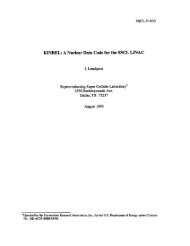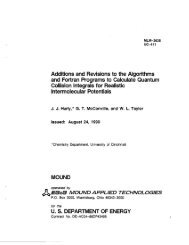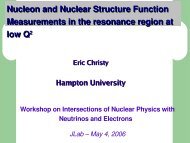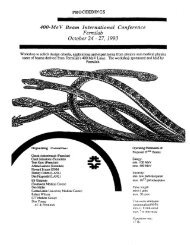Study of Frequency Multiplication Process in Multistage HGHG FEL ...
Study of Frequency Multiplication Process in Multistage HGHG FEL ...
Study of Frequency Multiplication Process in Multistage HGHG FEL ...
You also want an ePaper? Increase the reach of your titles
YUMPU automatically turns print PDFs into web optimized ePapers that Google loves.
DESY 01-056 ISSN 0418-9833<br />
July 2001<br />
<strong>Study</strong> <strong>of</strong> <strong>Frequency</strong> <strong>Multiplication</strong> <strong>Process</strong> <strong>in</strong><br />
<strong>Multistage</strong> <strong>HGHG</strong> <strong>FEL</strong><br />
W. Brefeld a, B. Faatz a, J. Feldhaus a, M. I(orfer a,<br />
J. Krzyw<strong>in</strong>ski b, T. Moller a, J. Pfiuegera, J. Rossbach a,<br />
E.L. Sald<strong>in</strong> a, E.A. Schneidmiller a S. Schreiber a and<br />
M.V. Yurkov c<br />
aDeutsches Elektronen-Synchrotron (DESY), Notkestrasse 85, D-22607 Hamburg,<br />
Germany<br />
b Institute <strong>of</strong> Physics <strong>of</strong> the Polish Academy <strong>of</strong> Sciences, 02688 Warszawa, Poland<br />
C Jo<strong>in</strong>t Institute for Nuclear Research, Dubna, 141980 Moscow Region, Russia<br />
Abstract<br />
A new design for multistage High-Ga<strong>in</strong> Harmonic Generation (<strong>HGHG</strong>) scheme is<br />
proposed. Each stage (except first) consists <strong>of</strong> radiator undulator, dispersion section<br />
(demodulator), <strong>FEL</strong> amplifier and end-stage dispersion section (modulator). The<br />
second harmonic <strong>in</strong> the nth stage becomes the fundamental <strong>in</strong> the (n + l)th stage.<br />
The ma<strong>in</strong> difference with previous <strong>HGHG</strong> schemes is that <strong>in</strong> our scheme the <strong>HGHG</strong><br />
technique can be applied more than once <strong>in</strong> a <strong>HGHG</strong> cha<strong>in</strong> (s<strong>in</strong>gle bunch scheme).<br />
This is possible because the density modulation exit<strong>in</strong>g each stage is relatively small,<br />
10% and 1% for the fundamental and the second harmonic, respectively. Hence, a<br />
small energy modulation is sufficient to create this microbunch<strong>in</strong>g <strong>in</strong> the dispersion<br />
section. In this case the growth <strong>of</strong> the energy spread due to the <strong>HGHG</strong> process<br />
is much less than <strong>in</strong>itial energy spread, and exponential growth rate <strong>in</strong> the ma<strong>in</strong><br />
undulator is practically the same as without stage sequence. At chosen parameters<br />
for each stage the amplitude <strong>of</strong> second harmonic <strong>of</strong> density modulation dom<strong>in</strong>ates<br />
significantly over the amplitude <strong>of</strong> shot noise harmonic, and the modulation <strong>of</strong> the<br />
beam density can be used as <strong>in</strong>put signal for the next <strong>HGHG</strong> stage. Problems relat<strong>in</strong>g<br />
to X-ray <strong>HGHG</strong> <strong>FEL</strong> are discussed. Our studies have shown that the frequency<br />
multiplication process produces a noise degradation proportional to at least the<br />
square <strong>of</strong> the multiplication ratio. This prevents operation <strong>of</strong> <strong>HGHG</strong> <strong>FEL</strong> at a very<br />
short wavelength range. The results presented <strong>in</strong> this paper have demonstrated that<br />
the <strong>HGHG</strong> <strong>FEL</strong> approach is quite adequate for the VUV coherent source, but not<br />
scalable to X-ray devices.<br />
Prepr<strong>in</strong>t submitted to
1 Introduction<br />
Recent advances <strong>in</strong> accelerator techniques reveal the perspective to construct <strong>in</strong> the<br />
nearest future free electron lasers capable to operate <strong>in</strong> the X-ray wavelength band. Several<br />
projects <strong>of</strong> such <strong>FEL</strong>s are now under development [1,2]. The common feature <strong>of</strong> these<br />
projects is that they are based on a s<strong>in</strong>gle pass SASE <strong>FEL</strong> scheme. Peak and average brilliance<br />
<strong>of</strong> these sources <strong>of</strong> coherent radiation exceed significantly the correspond<strong>in</strong>g values<br />
presently available at the most advanced storage r<strong>in</strong>g synchrotron radiation sources. However,<br />
the quality <strong>of</strong> the output radiation <strong>of</strong> the s<strong>in</strong>gle pass SASE <strong>FEL</strong> is still far from ideal<br />
because <strong>of</strong> its short longitud<strong>in</strong>al coherence length. This is a consequence <strong>of</strong> the fact that<br />
the process <strong>of</strong> amplification <strong>in</strong> the SASE <strong>FEL</strong> starts from shot noise. As a result, the output<br />
radiation consists <strong>of</strong> a number <strong>of</strong> <strong>in</strong>dependent wavepackets (or spikes). The length <strong>of</strong><br />
each wavepacket is much less than the radiation pulse length and there is no phase correlation<br />
between the wavepackets. Therefore, the improvement <strong>of</strong> the longitud<strong>in</strong>al coherence<br />
<strong>of</strong> the X-ray SASE <strong>FEL</strong> is <strong>of</strong> great practical importance.<br />
At present two ways to overcome this problem are under development. One <strong>of</strong> thelTI<br />
is based on an idea to use a self-seed<strong>in</strong>g scheme [3-5]. In this scheme the <strong>FEL</strong> consists <strong>of</strong><br />
two undulators and a monochromator located between them. The first undulator operates<br />
<strong>in</strong> the l<strong>in</strong>ear regime <strong>of</strong> amplification start<strong>in</strong>g from shot noise, and the output radiation<br />
has usual SASE properties. After the exit <strong>of</strong> the first undulator the electron beam is<br />
guided through a bypass, and the radiation enters the monochromator which selects a<br />
narrow band <strong>of</strong> radiation. At the entrance <strong>of</strong> the second undulator the monochrolTIatic<br />
radiation is comb<strong>in</strong>ed with the electron beam and is amplified up to the saturation level.<br />
The output radiation <strong>of</strong> this two-stage <strong>FEL</strong> possesses all the features which usually refer<br />
to laser radiation: full transverse and longitud<strong>in</strong>al coherence <strong>of</strong> the radiation with<strong>in</strong> the<br />
radiation pulse, and stability <strong>of</strong> the output power [3,4].<br />
Another approach to produce completely coherent radiation consists <strong>in</strong> utiliz<strong>in</strong>g a highga<strong>in</strong><br />
harmonic generation (<strong>HGHG</strong>) <strong>FEL</strong> scheme. In the <strong>HGHG</strong> <strong>FEL</strong> the radiation output<br />
is derived from a coherent subharmonic seed pulse. Consequently, the optical properties<br />
<strong>of</strong> the H G H G <strong>FEL</strong> are expected to be a map <strong>of</strong> the characteristics <strong>of</strong> the high-quality seed<br />
laser. This has the benefit <strong>of</strong> provid<strong>in</strong>g radiation with a high degree <strong>of</strong> stability and control<br />
<strong>of</strong> the central wavelength, bandwidth energy and pulse duration which is absent from the<br />
SASE <strong>FEL</strong> source [6-10]. An idea <strong>of</strong> us<strong>in</strong>g two undulators, with the second undulator<br />
resonant to one <strong>of</strong> the harmonics <strong>of</strong> the first one, has been proposed <strong>in</strong> [6] to generate<br />
UV radiation. The first undulator is long enough to reach saturation and produce strong<br />
spatial bunch<strong>in</strong>g <strong>in</strong> harmonics. The bunched beam generates coherent radiation <strong>in</strong> the<br />
second undulator which follows immediately the first one. The next step <strong>in</strong> this direction<br />
was taken <strong>in</strong> [7], where the follow<strong>in</strong>g modifications <strong>of</strong> the scheme have been <strong>in</strong>troduced:<br />
(1) The first undulator is shortened significantly. The <strong>in</strong>put laser power is controlled <strong>in</strong><br />
such a way that the maximum energy modulation <strong>of</strong> the electron beam is about equal<br />
to the energy spread, but still far away from saturation.<br />
(2) A dispersion section is <strong>in</strong>troduced between the two undulators and optimized to<br />
generate maximum harmonics <strong>in</strong> the spatial bunch<strong>in</strong>g.<br />
(3) The second undulator is long enough <strong>in</strong> order to provide exponential growth <strong>of</strong> the<br />
1
Table 3<br />
Parameters <strong>of</strong> the magnetic system <strong>of</strong> <strong>HGHG</strong> <strong>FEL</strong> scheme<br />
Radiator und ulator<br />
Stage 1<br />
256 nm<br />
Stage 2<br />
128 nm<br />
Stage 3<br />
64 nm<br />
Stage 4<br />
32 nm<br />
Stage 5<br />
16 nm<br />
Ma<strong>in</strong><br />
8nm<br />
length <strong>of</strong> undulator, m<br />
period, cm<br />
peak field, T<br />
J{-value<br />
Demodulator chicane<br />
1.4<br />
5<br />
1.1<br />
5.5<br />
1.7<br />
4.5<br />
0.94<br />
4<br />
1.9<br />
4<br />
0.75<br />
2.8<br />
2<br />
3.3<br />
0.65<br />
2<br />
net momentum compaction, mm<br />
total chicane length, m<br />
0.3<br />
3<br />
0.3<br />
3<br />
0.3<br />
3<br />
0.03<br />
1.5<br />
lengh <strong>of</strong> each dipole magnet, m 0.25 0.25 0.25 0.25<br />
bend angle <strong>of</strong> each dipole, deg. 0.6 0.6 0.6 0.27<br />
magnetic field for each dipole, T<br />
<strong>FEL</strong> amplifier undulator<br />
0.15 0.15 0.15 0.067<br />
length <strong>of</strong> undulator, m 1.95 1.6 2.4 2.8 4.6 13.1<br />
period, cm 6.5 5 4.5 4 3.3 2.73<br />
peak field, T 1.1 1.1 0.94 0.75 0.65 0.5<br />
J{-value<br />
Mod ulator chicane<br />
6.8 5.5 4 2.8 2 1.26<br />
net momentum compaction, 11m 18 7.5 3.5 1.5<br />
total chicane length, m 1.5 1.5 1.5 1.5<br />
length <strong>of</strong> each dipole magnet, m 0.25 0.25 0.25 0.25<br />
bend angle <strong>of</strong> each dipole, deg. 0.2 0.13 0.09 0.06<br />
magnetic field for each dipole, T 0.05 0.033 0.023 0.015<br />
3<br />
EstiInation <strong>of</strong> space charge and coherent synchrotron radiation effects<br />
Let us beg<strong>in</strong> with the analysis <strong>of</strong> the space charge effects <strong>in</strong> the nl0dulated electron<br />
bealll mov<strong>in</strong>g along the z axis <strong>of</strong> planar undulator. Natural oscillations associated with<br />
the space charge force aris<strong>in</strong>g from a small displacement <strong>of</strong> charge can be derived <strong>in</strong><br />
several different ways, but here straightforward elementary approach is used. Let the beam<br />
excitation be periodic, s<strong>in</strong>usoidal <strong>in</strong> z. Beam modulation wavenumber k corresponds to<br />
the frequency w = kv z , where Vz = v - C[{2/(4,2) is the longitud<strong>in</strong>al velocity <strong>of</strong> electrons<br />
with nom<strong>in</strong>al energy Eo, averaged over undulator period. Let us <strong>in</strong>troduce the coord<strong>in</strong>ate<br />
s = z - vzt. The beam current jz is a periodic function <strong>of</strong> the phase ks and can be<br />
expanded <strong>in</strong> a Fourier series:<br />
00<br />
jz = L<br />
n=l<br />
jn cos(nks + 'lfJn) ,<br />
where jn anjo and 1/Jn are the amplitude and phase <strong>of</strong> the nth harmonic <strong>of</strong> the beam<br />
current density, jo is the beam current density, and an is the amplitude <strong>of</strong> first harmonic<br />
<strong>of</strong> reduced beam current density. When the transverse size <strong>of</strong> the electron beam is large,<br />
(J; » c 2 ,:/w2, the longitud<strong>in</strong>al space charge field <strong>of</strong> the electron beam is def<strong>in</strong>ed by<br />
the local density modulation. In the framework <strong>of</strong> the one-dimensional model we can<br />
11
e negligible cOlnpared to the shot noise <strong>in</strong>fluence <strong>in</strong> the 1st stage. Nevertheless, the<br />
problem <strong>of</strong> calculation <strong>of</strong> <strong>HGHG</strong> <strong>FEL</strong> noise factor is more cOlnplicated and there are<br />
situations where, for <strong>in</strong>stance, shot noise <strong>in</strong> the second stage can provide comparable or<br />
even larger output signal perturbation than shot noise <strong>in</strong> the first stage. As a result, we<br />
can conclude only that <strong>in</strong> practical situations noise factor satisfies <strong>in</strong>equality F > N 2 •<br />
COlnplete description <strong>of</strong> the noise output <strong>of</strong> <strong>HGHG</strong> <strong>FEL</strong> can be performed only with<br />
numerical simulation codes. The specific numerical example <strong>of</strong> subharmonically seeded<br />
s<strong>of</strong>t X-ray <strong>FEL</strong>, which we present below, illustrates the complexity <strong>of</strong> shot noise effects<br />
<strong>in</strong> a <strong>HGHG</strong> <strong>FEL</strong>.<br />
5<br />
NUluerical study <strong>of</strong> the harmonic generation process <strong>in</strong> a mUltistage <strong>HGHG</strong><br />
<strong>FEL</strong><br />
Numerical example for multistage <strong>HGHG</strong> <strong>FEL</strong> is given for project parameters <strong>of</strong> the<br />
electron beam at the TESLA Test Facility (see Table 1). <strong>FEL</strong> project at the TTF will<br />
proceed <strong>in</strong> two stages. The first stage assumes runn<strong>in</strong>g conventional SASE <strong>FEL</strong> scheme,<br />
and at the second stage it will be upgraded <strong>in</strong>to the self-seed<strong>in</strong>g option. General parameters<br />
for these two options are given <strong>in</strong> Tables 4 and 5. Figure 6 presents typical temporal and<br />
spectral structure <strong>of</strong> the radiation pulse.<br />
Table 4<br />
Parameters <strong>of</strong> conventional SASE <strong>FEL</strong> at TTF<br />
I Undulator with separate focus<strong>in</strong>g system I<br />
Undulator*<br />
Period<br />
Gap<br />
Peak magnetic field<br />
External ,B-function<br />
rms beam size<br />
Output radiation<br />
'Vavelength<br />
Saturation length<br />
Peak power<br />
Average power<br />
Spot size at the undulator exit (FWHM)<br />
Angular divergence (F'VHM)<br />
Bandwidth (FWHM)<br />
Pulse duration (FWHM)<br />
Peak fl ux <strong>of</strong> photons<br />
Average fl ux <strong>of</strong> photons<br />
Peak spectral brilliance<br />
Average spectral brilliance<br />
Units 6.4 nm 13 nm 30 nm<br />
cm<br />
mm<br />
T<br />
m<br />
pm<br />
nm<br />
m<br />
GW<br />
W<br />
11m<br />
J.Lrad<br />
%<br />
fs<br />
#/sec<br />
#/sec<br />
B**<br />
B**<br />
*Hybrid, planar undulator.<br />
**In units <strong>of</strong> photons/sec/mrad 2 Imm 2 1(0.1 % bandwidth).<br />
17<br />
68<br />
6.4<br />
26.2<br />
2.8<br />
40<br />
190<br />
24<br />
0.36<br />
200<br />
9 X 10 25<br />
1.3 X 10 18<br />
2.4 X 10 30<br />
3.5 X 10 22<br />
2.73<br />
12<br />
0.495<br />
4.5<br />
80<br />
13<br />
21.2<br />
2.5<br />
35<br />
220<br />
40<br />
0.46<br />
200<br />
1.6 X 10 26<br />
2.3 X 10 18<br />
8.1 X 10 29<br />
1.2 X 10 22<br />
100<br />
30<br />
17.8<br />
1.8<br />
27<br />
270<br />
70<br />
0.62<br />
200<br />
2.8 X 10 26<br />
4 X 10 18<br />
2 X 10 29<br />
2.9 X 10 21
Table 5<br />
Parameters <strong>of</strong> self-seed<strong>in</strong>g SASE <strong>FEL</strong> at TTF<br />
Undulator<br />
Type Planar<br />
Period, Aw<br />
2.73 cm<br />
Peak magnetic field, Hw 4.97 kGs<br />
Length <strong>of</strong> 1st undulator 13 m<br />
Length <strong>of</strong> 2nd undulator 17 m<br />
External ,a-function, 300 cm<br />
nns transverse beam size<br />
Output radiation<br />
57/-lm<br />
Wavelength, A 6.4 nm<br />
Bandwidth, £lA/A<br />
7 X 10-5 rms angular divergence 15 /-lrad<br />
nns spot size 90/-lm<br />
Time <strong>of</strong> coherence, Tc 100 fs<br />
Power average over pulse 2GW<br />
Flash energy 0.6 mJ<br />
Fluctuations <strong>of</strong> the flash energy 5%<br />
Average power 40W<br />
Despite conventional SASE <strong>FEL</strong> is capable to provide much higher peak brilliance than<br />
synchrotron radiation sources, it still possesses a high potential for its further <strong>in</strong>crease.<br />
Ma<strong>in</strong>ly brilliance <strong>of</strong> the output radiation from the SASE <strong>FEL</strong> is limited by poor longitud<strong>in</strong>al<br />
coherence <strong>of</strong> the radiation: it consists <strong>of</strong> a large number <strong>of</strong> statistically <strong>in</strong>dependent<br />
wavepackets (see Fig. 6). This is natural consequence <strong>of</strong> the start-up from shot noise <strong>of</strong><br />
the <strong>FEL</strong> amplification process. An improvement <strong>of</strong> the longitud<strong>in</strong>al coherence is possible<br />
only when coherent radiation from external source is fed to the undulator entrance. The<br />
power <strong>of</strong> the seed radiation must exceed significantly effective power <strong>of</strong> shot noise <strong>in</strong> the<br />
electron beam <strong>in</strong> order to obta<strong>in</strong> fully coherent radiation at the exit <strong>of</strong> the <strong>FEL</strong> amplifier.<br />
The value <strong>of</strong> effective shot noise power is relatively high. Typically it is <strong>in</strong> the range from<br />
about one hundred Watt (<strong>FEL</strong> <strong>of</strong> optical wavelength range) up to few kilowatts (an X-ray<br />
<strong>FEL</strong>). Presently available coherent radiation sources allow to solve the seed<strong>in</strong>g problem<br />
only for <strong>FEL</strong>s operat<strong>in</strong>g <strong>in</strong> optical wavelength range.<br />
Two-stage (or, self-seed<strong>in</strong>g) SASE <strong>FEL</strong> scheme provides the possibility <strong>of</strong> effective<br />
seed<strong>in</strong>g [3]. This schenle consists <strong>of</strong> two undulators and a monochromator located between<br />
the<strong>in</strong>. Modern techniques allows one to design and manufacture monocrOlnators with<br />
required parameters which are capable to cover wavelength range from an optical down<br />
to an X-ray band. The spectral bandwidth <strong>of</strong> the radiation from two-stage SASE <strong>FEL</strong> is<br />
def<strong>in</strong>ed by the f<strong>in</strong>ite duration <strong>of</strong> the electron pulse. The shot-to-shot fluctuations <strong>of</strong> energy<br />
spectral density are dramatically reduced <strong>in</strong> comparison with the 100 % fluctuations <strong>in</strong><br />
a SASE <strong>FEL</strong> [4]. The peak and average brilliance are by two orders <strong>of</strong> Inagnitude higher<br />
than the values which could be reached by a conventional X-ray SASE <strong>FEL</strong> (see Tables 4<br />
and 5) The price for a better quality <strong>of</strong> output radiation is <strong>in</strong>crease <strong>of</strong> the scale <strong>of</strong> the<br />
facility. First, the total undulator length should be <strong>of</strong> about 1.5 times larger than for<br />
conventional scheme. Second, monochromator and bypass for the electron beam require<br />
18
(5) The beanl enters the <strong>FEL</strong> amplifier undulator resonant at the wavelength <strong>of</strong> 128 nnl.<br />
The seed<strong>in</strong>g signal for this amplifier consists <strong>of</strong> two contributions: radiation produced<br />
<strong>in</strong> the radiator undulator (which conta<strong>in</strong>s noise contribution developed <strong>in</strong> the previous<br />
undulators), and the shot noise <strong>in</strong> the electron bealn at the wavelength <strong>of</strong> 128 nm.<br />
Maximal value <strong>of</strong> the radiation power at the exit <strong>of</strong> this stage is about 25 MW.<br />
(6) The simulations procedure cont<strong>in</strong>ues as it is described start<strong>in</strong>g from item (2) until<br />
the wavelength reaches the value <strong>of</strong> 8 nm.<br />
(7) F<strong>in</strong>ally, the <strong>FEL</strong> process is calculated until saturation level <strong>in</strong> the ma<strong>in</strong> undulator.<br />
So, the described algorithm gives a clear idea on the simulation procedure. Let us<br />
turn now to analysis <strong>of</strong> obta<strong>in</strong>ed results. All numerical results are illustrated for two<br />
cases: with and without tak<strong>in</strong>g <strong>in</strong>to account shot noise <strong>in</strong> the electron beam. We start<br />
with the case <strong>of</strong> a long seed<strong>in</strong>g optical pulse, 5 ps FWHM (see Figs. 7-11). When we<br />
trace the behaviour <strong>of</strong> an idealized case (without tak<strong>in</strong>g <strong>in</strong>to account shot noise), we<br />
obta<strong>in</strong> perfect quality radiation pulse (both <strong>in</strong> temporal and spectral doma<strong>in</strong>) at the<br />
exit <strong>of</strong> <strong>HGHG</strong> <strong>FEL</strong>. However, tak<strong>in</strong>g <strong>in</strong>to account noise effect results <strong>in</strong> a degradation <strong>of</strong><br />
the quality <strong>of</strong> the radiation pulse from stage to stage. As we mentioned <strong>in</strong> the previous<br />
section, the <strong>HGHG</strong> <strong>FEL</strong> scheme, as well as any frequency multiplication scheme possesses<br />
significant <strong>in</strong>tr<strong>in</strong>sic disadvantage. N alnely, contribution <strong>of</strong> the shot noise power to the<br />
signal grows quadratically with the number <strong>of</strong> harmonic to be generated. The results <strong>of</strong><br />
nUlnerical simulations are <strong>in</strong> good agreement with simple physical est<strong>in</strong>lations presented<br />
<strong>in</strong> the previous section. The growth <strong>of</strong> the noise contribution is clearly illustrated with<br />
the plots for the phase <strong>of</strong> the radiation field (see Figs. 7 and 8). The plots for radiation<br />
spectrum are presented <strong>in</strong> Fig. g. Analysis <strong>of</strong> the present numerical example shows that<br />
the shot noise <strong>in</strong> the first stage gives relatively small contribution to the f<strong>in</strong>al value <strong>of</strong><br />
the noise to signal ratio at the exit <strong>of</strong> the <strong>HGHG</strong> scheme. This is achieved by means <strong>of</strong><br />
<strong>in</strong>crease <strong>of</strong> the power <strong>of</strong> seed radiation. However, <strong>HGHG</strong> scheme does not allow to do this<br />
for the next stages when a small beam density modulation serves as <strong>in</strong>put signal. In our<br />
case the ma<strong>in</strong> contribution <strong>of</strong> noise degradation comes from the second stage. The third<br />
stage also gives visible contribution to the noise.<br />
The nlost critical issue <strong>of</strong> the s<strong>in</strong>gle-bunch <strong>HGHG</strong> scheme is growth <strong>of</strong> uncorrelated<br />
energy spread. However, parameters <strong>of</strong> the stages can be optimized <strong>in</strong> such a way that<br />
this effect almost does not lead to degradation <strong>of</strong> output radiation. Figure 11 illustrates<br />
the energy spread <strong>in</strong> the electron bunch at the entrance to the ma<strong>in</strong> undulator. It is seen<br />
that the <strong>in</strong>crease <strong>of</strong> uncorrelated energy spread is 20% only.<br />
An attractive feature <strong>of</strong> the <strong>HGHG</strong> scheme is that it is capable to produce shorter<br />
pulses than the self-seed<strong>in</strong>g option (see Table 5 and Fig. 6). Even with a long seed<strong>in</strong>g pulse<br />
the FWHM pulse duration <strong>of</strong> output radiation is about 80 fs. It is at least twice shorter<br />
than that produced by conventional SASE <strong>FEL</strong> (see Fig. 6). We performed a dedicated<br />
study <strong>of</strong> capabilities <strong>of</strong> <strong>HGHG</strong> scheme seeded by a short seed<strong>in</strong>g pulse (30 fs FWHM).<br />
Our calculations show that output signal has pulse duration <strong>of</strong> about 10 fs FWHM. Of<br />
course, the noise degradation also takes place as it is seen from Figs. 12 and 13. One can<br />
wonder why the peak output power <strong>of</strong> the <strong>HGHG</strong> <strong>FEL</strong> seeded by a short pulse is larger<br />
with respect to the <strong>HGHG</strong> <strong>FEL</strong> seeded by a long pulse. This is not a general feature <strong>of</strong><br />
the <strong>HGHG</strong> <strong>FEL</strong> scheme, but a natural consequence <strong>of</strong> the specific s<strong>in</strong>gle-bunch scheme<br />
proposed <strong>in</strong> this paper. Explanation <strong>of</strong> discussed phenomenon comes from analysis <strong>of</strong> the<br />
26
References<br />
[1] "TESLA Technical Design Report" (Editors: F. Richard, J. R. Schneider, D. Tr<strong>in</strong>es, A.<br />
Wagner)TESLA Report 2001-23, TESLA-<strong>FEL</strong> Report 2001-05, Hamburg, 2001<br />
[2] "L<strong>in</strong>ac Coherent Light Source (LCLS) Design <strong>Study</strong> Report", SLAC Report No. SLAC-R<br />
521, 1998<br />
[3] J. Feldhaus et al., Optics Communications 140(1997)341<br />
[4] E. L. Sald<strong>in</strong>, E. A. Schneidmiller and M. V. Yurkov, Nucl. lnstrum. and Methods A<br />
445(2000)178<br />
[5] "Seed<strong>in</strong>g Option for the VUV Free Electron Laser at DESY": Proposal. Available at DESY<br />
by request only<br />
[6] R. Bonifacio, L. De Salvo, and P. Pier<strong>in</strong>i, Nucl. lnstrum. and Methods A293(1990)627<br />
[7] L. H. Yu, Phys. Rev. A44(1991)5178<br />
[8] 1. Ben-Zvi et al., Nucl. lnstrum. and Methods A304(1991)151<br />
[9J 1. Ben-Zvi et al., Nucl. lnstrum. and Methods A393(1997)II-I0<br />
[10] L. H. Yu and 1. Ben-Zvi, Nucl. lnstrum. and Methods A393(1997)96<br />
[11] L. H. Yu et al., Nucl. lnstrum. and Methods A445(2000)301<br />
[12] A. Doyuran et al., "Characterization <strong>of</strong> a High-Ga<strong>in</strong> Harmonic- Generation Free Electron<br />
Laser at Saturation" BNL-68031, submitted to Phys. Rev. Lett. January 2001<br />
[13J L. H. Yu "Seeded <strong>FEL</strong>s and Expected performance", Proceed<strong>in</strong>gs <strong>of</strong> the lCFA Advansed<br />
Beam Dynamics Workshop on Future Light Sources, C. E. Eyberger, Ed., Argone National<br />
Laboratory, Argonne, IL (1999).<br />
[14] J. Rossbach, Nucl. lnstrum. and Methods A 375(1996)269<br />
[15] "Development <strong>of</strong> a pump-probe facility with sub-picosecond time resolution comb<strong>in</strong><strong>in</strong>g a<br />
high-power optical laser and a s<strong>of</strong>t X-ray free electron laser": Proposal. Available at DESY<br />
by request only<br />
[16] A. Faltens and L. J. Laslett, Part. Accel. 4(1973)151<br />
[17] J. B. Murphy, S. Kr<strong>in</strong>sky and R. L. Gluckstern, Part. Accel. 57(1997)9'<br />
[18] E. L. Sald<strong>in</strong>, E. A. Schneidmiller and M. V. Yurkov, "The physics <strong>of</strong> Free Electron Lasers"<br />
Spr<strong>in</strong>ger-Verlag, Berl<strong>in</strong>, 1999<br />
[19] E. L. Sald<strong>in</strong>, E. A. Schneidmiller and M. V. Yurkov, Nuc1. lnstrum. and Methods A<br />
429(1999)233<br />
[20] W. P. Rob<strong>in</strong>s "Phase noise <strong>in</strong> signal sources" lEE Telecommunications series 9, Peter<br />
Peregr<strong>in</strong>us Ltd, 1982<br />
29
















